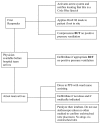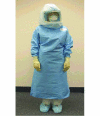Using simulation for training and to change protocol during the outbreak of severe acute respiratory syndrome
- PMID: 16356209
- PMCID: PMC1550819
- DOI: 10.1186/cc3916
Using simulation for training and to change protocol during the outbreak of severe acute respiratory syndrome
Abstract
Introduction: During the 2003 severe acute respiratory syndrome (SARS) crisis, we proposed and tested a new protocol for cardiac arrest in a patient with SARS. The protocol was rapidly and effectively instituted by teamwork training using high-fidelity simulation.
Methods: Phase 1 was a curriculum design of a SARS-specific cardiac arrest protocol in three steps: planning the new protocol, repeated simulations of this protocol in a classroom, and a subsequent simulation of a cardiac arrest on a hospital ward. Phase 2 was the training of 275 healthcare workers (HCWs) using the new protocol. Training involved a seminar, practice in wearing the mandatory personal protection system (PPS), and cardiac arrest simulations with subsequent debriefing.
Results: Simulation provided insights that had not been considered in earlier phases of development. For example, a single person can don a PPS worn for the SARS patient in 1 1/2 minutes. However, when multiple members of a cardiac arrest team were dressing simultaneously, the time to don the PPS increased to between 3 1/2 and 5 1/2 minutes. Errors in infection control as well as in medical management of advanced cardiac life support (ACLS) were corrected.
Conclusion: During the SARS crisis, real-time use of a high-fidelity simulator allowed the training of 275 HCWs in 2 weeks, with debriefing and error management. HCWs were required to manage the SARS cardiac arrest wearing unfamiliar equipment and following a modified ACLS protocol. The insight gained from this experience will be valuable for future infectious disease challenges in critical care.
Figures
References
-
- Centers for Disease Control and Prevention (CDC) Outbreak of severe acute respiratory syndrome – worldwide, 2003. MMWR Morb Mortal Wkly Rep. 2003;52:226–228. - PubMed
-
- Centers for Disease Control and Prevention (CDC) Cluster of severe acute respiratory syndrome cases among protected health-care workers – Toronto, Canada, April 2003. MMWR Morb Mortal Wkly Rep. 2003;52:433–436. - PubMed
-
- Directives To All Ontario Acute Care Hospitals for High-Risk Procedures involving SARS Patients Critical Care Areas http://www.health.gov.on.ca/english/providers/program/pubhealth/sars/doc...
-
- Working Group on Adjunctive Protective Equipment for High-Risk Procedures in SARS patients http://sars.medtau.org/adjunctreport.doc
MeSH terms
LinkOut - more resources
Full Text Sources
Miscellaneous



